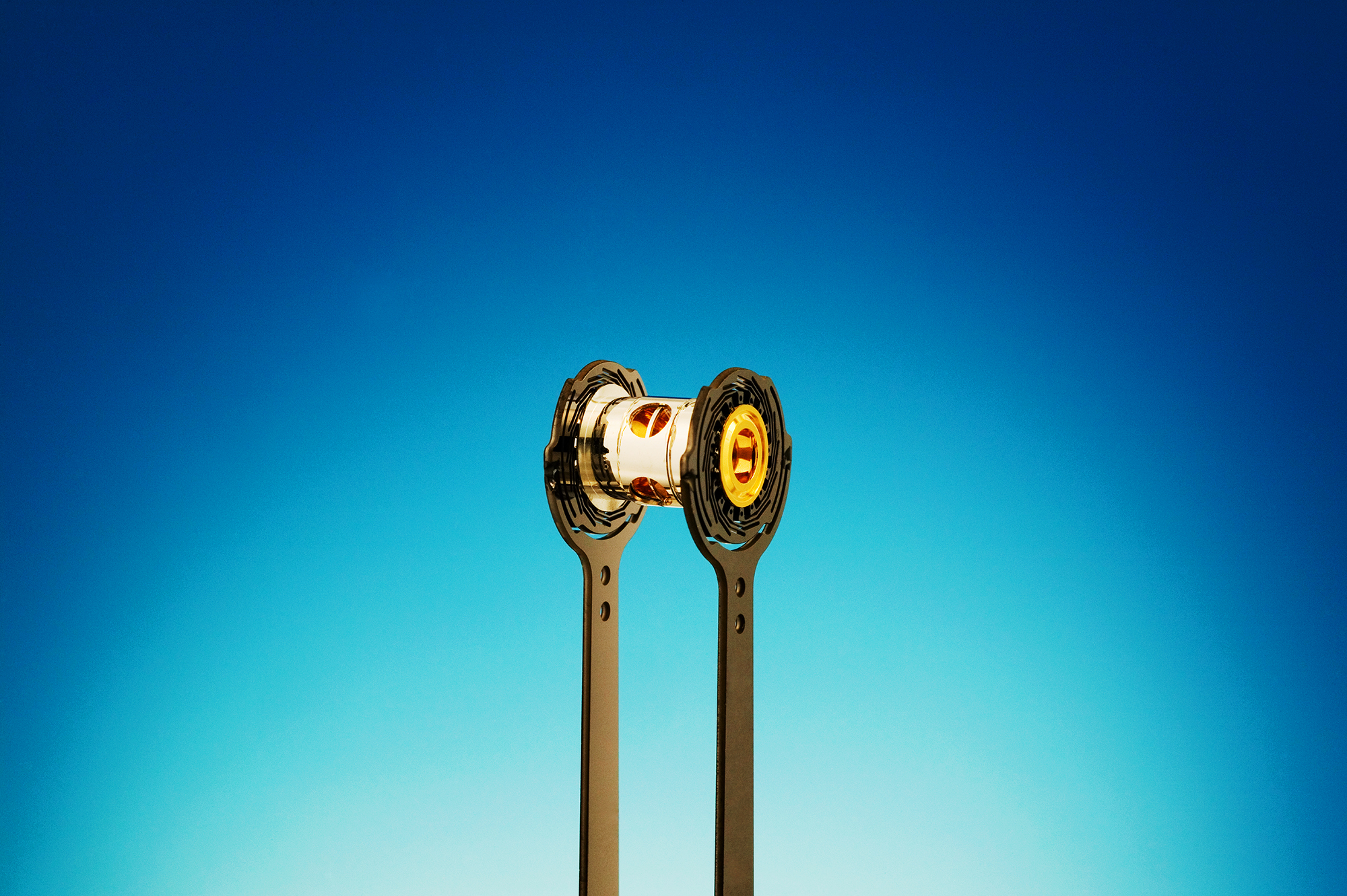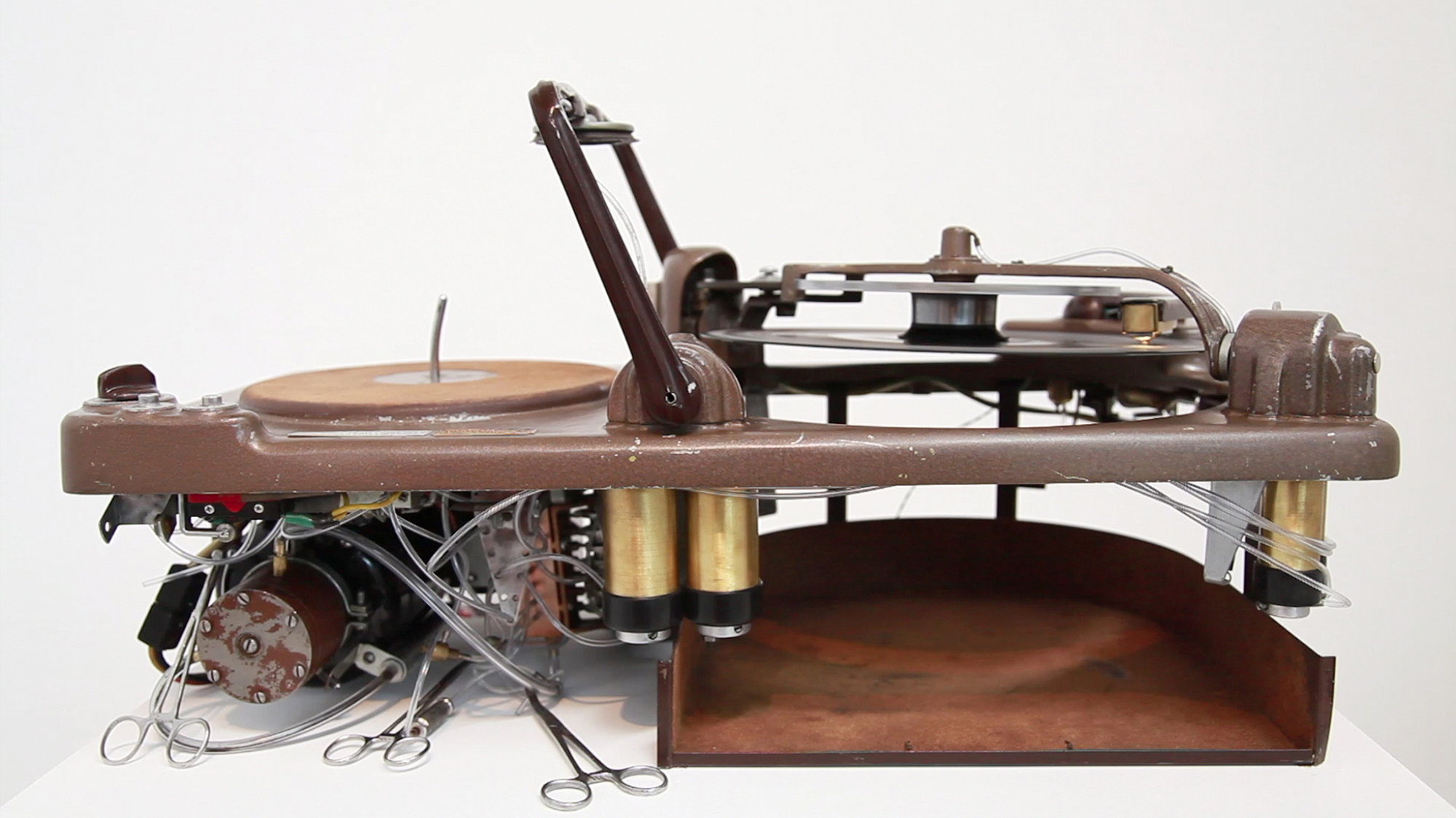Horror Vacui
.46 carat synthetic diamond made from the artist, restored Lincoln 50 pneumatic phonograph, 33 RPM record; Side A: single cell communication Side B: recording of nearby pulsar radio waves, graphite crucible, master plates, artificial star chamber, 26" x 37" framed pigment print, diamond star map, 20" x 20" framed pigment print
26" x 14" x 14" record changer, installation dimensions variable
Edition of 25 33rpm records
Nature Abhors a Vacuum is based on a cyclical concept of energy, matter, and history, that posits the universe has been recurring, and will continue to recur, in a self-similar form across infinite time and space, reconfiguring its matter in a number of indifferent outcomes. The project is hinged on a heavily researched and investigated series of conceptual narratives. These narratives interweave the story of a violin player who was cremated and made into a diamond stylus to play back his violin music, the Voyager Interstellar disc that contained all the sounds and images of earth that was sent into space to be found by another intelligent civilization in the future, and the restoration of a rare pneumatic phonograph developed by engineers coming back from World War II. The synergy of these narratives confuses subjects and objects, considers entropy as information to be recovered and reconfigured, and re-appropriates energy as an interchangeable medium that oscillates between being a historical narrative and the imagination of science. The result is a self-contained system whose logic and fantasy are one and the same; where the operation of the phonograph begins to recall a perpetual motion machine that expresses, destroys, and rewrites its own story with each rotation.
A .46 carat synthetic diamond was produced by extracting the artist’s carbon from an 8 gram hair sample that was then packed and compressed inside a diamond press that recreated the heat and pressure of the Earth. After a year in the press, a rough diamond was obtained that was then precision ground and faceted to .7 thousandths of an inch at its point to enable LP play back as the needle for a pneumatic phonograph. However, due to the large mass of the diamond, the angle that was cut is several micrometres wider than the record groove causing it to sporadically serve as the pick up for play back while also routing the record out and destroying the information encrypted into the grooves. The routing of the record also alters the optics of the diamond hourglass shape mirrored in the record as the static charge surrounding it attracts the shavings and dust from the record that then cling to the outside of the diamond. Despite the seemingly unique originality of the diamond creation process, it is made up of the banal matter that is within all organic compounds and therefore completely interchangeable with any other person or object.
The Lincoln 50 pneumatic phonograph that the synthetic diamond was fitted for was obtained from the estate of the Lincoln engineering family, was manufactured in 1949, and uses a vacuum pump system that actuates every movement of the changer. This vacuum system displaces the matter contained within the vacuum lines and in doing so takes away the medium that sound travels through because there are few molecules to compress and decompress on. Then, it uses this pressure to actuate pistons that produce sound by moving the mechanisms that serve to play the record in normal atmospheric pressure. Essentially, the changers play back is actuated by nothing, and the lack of sound in the vacuum ultimately produces sound and becomes an inverse of this process in the vacuum of space.
The recorded vinyl audio on Side A was obtained from translating a single cell’s communication after readings were made using an EEG that usually measures human brain waves.
The Side B audio was obtained from the National Radio Astronomy Observatory and is a compilation of radio waves heard from nearby pulsars (dead rotating stars that can be heard as waves when listening at distinct frequencies facing towards the Earth).
Jorge Hiller, a German violinist who, after his passing in 2009, was cremated along with his violin, was synthesized into a precision faceted diamond that was used as a phonograph needle to play back his violin music that had been recorded to vinyl during his lifetime.
The Voyager Interstellar Disc launched into space in 1977 and included images, sounds, and greetings from Earth depicting the time and place of their origin to other intelligent civilizations on a 12” copper plated disc with accompanying stylus and instructions for play back.
A Lincoln 50 pneumatic record changer obtained from the estate of the Lincoln Engineering family. The pneumatic changers movements are actuated entirely from a vacuum pump system. This was the first unit capable of playing 33, 45, 78rpm records, flipping the record upside down to play the B Side using a vacuum seal and was used as a commercial unit in department stores to play Muzak. The Lincoln was utilized for these purposes because it could be played for up to 16 hours with no maintenance.
A .46 carat synthetic diamond was produced by extracting the artist’s carbon from an 8 gram hair sample that was then packed and compressed inside a diamond press that recreated the heat and pressure of the Earth. After a year in the press, a rough diamond was obtained that was then precision ground and faceted to .7 thousandths of an inch at its point to enable LP play back as the needle for a pneumatic phonograph. However, due to the large mass of the diamond, the angle that was cut is several micrometres wider than the record groove causing it to sporadically serve as the pick up for play back while also routing the record out and destroying the information encrypted into the grooves. The routing of the record also alters the optics of the diamond hourglass shape mirrored in the record as the static charge surrounding it attracts the shavings and dust from the record that then cling to the outside of the diamond. Despite the seemingly unique originality of the diamond creation process, it is made up of the banal matter that is within all organic compounds and therefore completely interchangeable with any other person or object.
The Lincoln 50 pneumatic phonograph that the synthetic diamond was fitted for was obtained from the estate of the Lincoln engineering family, was manufactured in 1949, and uses a vacuum pump system that actuates every movement of the changer. This vacuum system displaces the matter contained within the vacuum lines and in doing so takes away the medium that sound travels through because there are few molecules to compress and decompress on. Then, it uses this pressure to actuate pistons that produce sound by moving the mechanisms that serve to play the record in normal atmospheric pressure. Essentially, the changers play back is actuated by nothing, and the lack of sound in the vacuum ultimately produces sound and becomes an inverse of this process in the vacuum of space.
The recorded vinyl audio on Side A was obtained from translating a single cell’s communication after readings were made using an EEG that usually measures human brain waves.
The Side B audio was obtained from the National Radio Astronomy Observatory and is a compilation of radio waves heard from nearby pulsars (dead rotating stars that can be heard as waves when listening at distinct frequencies facing towards the Earth).
Jorge Hiller, a German violinist who, after his passing in 2009, was cremated along with his violin, was synthesized into a precision faceted diamond that was used as a phonograph needle to play back his violin music that had been recorded to vinyl during his lifetime.
The Voyager Interstellar Disc launched into space in 1977 and included images, sounds, and greetings from Earth depicting the time and place of their origin to other intelligent civilizations on a 12” copper plated disc with accompanying stylus and instructions for play back.
A Lincoln 50 pneumatic record changer obtained from the estate of the Lincoln Engineering family. The pneumatic changers movements are actuated entirely from a vacuum pump system. This was the first unit capable of playing 33, 45, 78rpm records, flipping the record upside down to play the B Side using a vacuum seal and was used as a commercial unit in department stores to play Muzak. The Lincoln was utilized for these purposes because it could be played for up to 16 hours with no maintenance.




